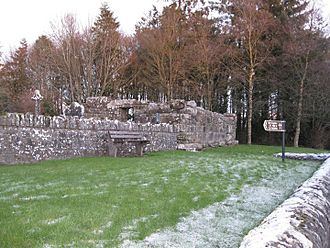Cathedral of Saint Mel in Ardagh facts for kids
Quick facts for kids Cathedral of Saint Mel |
|
|---|---|

Cathedral of Saint Mel in Ardagh
|
|
| General information | |
| Coordinates | Lua error in Module:Coordinates at line 614: attempt to index field 'wikibase' (a nil value). |
The Cathedral of Saint Mel is an old, ruined church found in the small village of Ardagh, County Longford in Ireland. It's important not to confuse it with the much larger St Mel's Cathedral in the town of Longford.
Even though it's called Saint Mel's Cathedral, this ruined church was actually built about 300 years after Saint Mel lived. In the 1100s, changes in the church made this site in Ardagh a very important place. It became the main church, or Cathedral, for the Diocese of Ardagh and Clonmacnoise. This showed how significant the site was as a center for the church.
Contents
History
Early Beginnings
Long ago, people believed that a special religious community, called a monastery, was started in Ardagh by St. Patrick. He supposedly made his nephew, Saint Mel, its first bishop or leader.
There isn't any old proof or archaeological finds to show this story is true. However, St. Mel is still widely thought of as the person who started the church area known as the Diocese of Ardagh and Clonmacnoise.
What Happened to It?
Sadly, the church building was badly damaged during a war in the year 1496. After this, it was never fixed or rebuilt. This is why we only see its ruins today.
What It Looks Like Now
The Old Church Building
The ruins you see today are typical of an early medieval church. It was a simple rectangular room. You would enter through a doorway on the western side. This doorway had a flat stone top and sides that got narrower from the bottom to the top.
The building itself is about 10.35 meters (about 34 feet) long and 7.70 meters (about 25 feet) wide. The large stone blocks that make up the walls sit on a slightly raised stone base. Some of the limestone blocks in the walls are very big, measuring about 2.5 meters (over 8 feet) long and 0.90 meters (about 3 feet) wide. The roof would have been very steep. It was likely supported by special stone parts at the corners of the building called antae.
Digging Up the Past
Archaeologists, who are like history detectives, did excavations at this site in 1967. During their digging, they found the outline of an older wooden building. This wooden structure dated back to the 8th century AD. What's really interesting is that it was almost the exact same size as the stone church we see standing today. This suggests the stone church was built right on top of where the wooden one used to be.
Gallery
See also
 In Spanish: Catedral de San Mel (Ardagh) para niños
In Spanish: Catedral de San Mel (Ardagh) para niños








